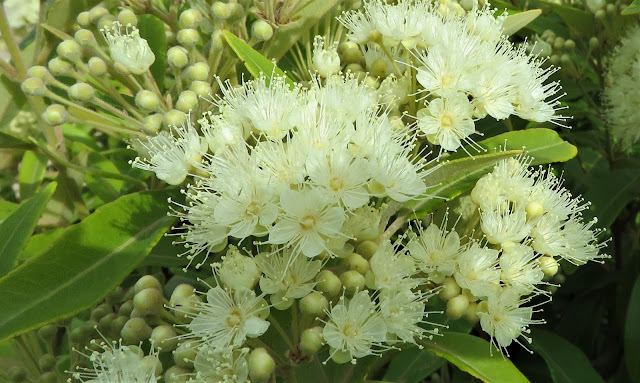The buzz around lemonade substitute
Let me take you back to late summer, to the time before COVID-19 reached Australia. A time when the bushfires ravaging much of eastern Australia were mostly under control, although the salvaging of lives, property and forests had only just begun - and continues today.
Back then we were looking for signs of hope in the bush and in our home gardens. So in February, when I took these pictures in the Australian Garden at Cranbourne Gardens, social media was abuzz with images of the Lemon Myrtle. The bee-ridden images were often flanked by comments about the heady lemon aroma of its crushed leaves, rather than the honey-scented flowers.
In addition to flavouring food and booze, brewing for tea and livening up the bouquets of soaps and shampoos, the leaves (uncrushed and attached to their host) may be worth considering if you live near bushland. While the leaves of Lemon Myrtle are rich in oils, this species is recommended for planting in fire-prone areas.
Backhousia citriodora, the Lemon Myrtle, is one of ten species of Backhousia, a genus in the myrtle family found in the coastal rainforests of northern New South Wales and Queensland. This one comes from Queensland only, extending from Brisbane to Mackay.
While growing in rainforest it is quite tolerant of dryer conditions when growing in well-mulched soil. Although often grown in shade or part shade, these Lemon Myrtle hedges are exposed to the full brunt of Cranbourne weather.
One of my predecessors in this job (you know I do like saying that), Ferdinand von Mueller, described Backhousia citriodora in 1853. The genus honours his friend James Backhouse, an English botanist who visited Australia in the 1830s, and the species name is all about the aroma of the crushed leaves, due to a chemical called citral.
Lemon Myrtle is the richest natural source of citral, a pale yellow, volatile liquid with a strong lemon odor found in various unrelated plants (e.g. lemongrass and verbena). There are plenty of scientific, and not so scientific, papers on the efficacy of lemon myrtle oil for solving some of life troubles.
In one of the most recent peer-reviewed papers, from collaborating laboratories in Korea, the anti-inflammatory and anti-oxidative properties the various chemicals in lemon myrtle extract are investigated, concluding that these extracts 'could be used to treat inflammatory bowel disease'. But as always, do not even think of treating a serious illness with an unmeasured and tested botanical product.
As you would expect, Aboriginal communities in north-eastern Australia use Lemon Myrtle as a flavouring for food, and while there are (or at least in 2013, were) no written reports of it being used as medicine I bet it was.
Western use of Lemon Myrtle seems to date back to the late nineteenth century, when a German company isolated citral from its leaves, followed shortly by commercial production in southern Queensland. In modern Australia, its heyday was apparently the Second World War, when it was used by soft drink company Tarax, to flavour their lemonade.
Let me finish with picture of Lemon Myrtle from Sydney's Royal Botanic Garden. This towering specimen also seems happy fully exposed to the local sunshine.




Comments
Zeny Edwards
As a mainly coffee drinker myself I reckon that you should broaden your beverage experience by having lemon myrtle tea (best to use fresh leaves) also makes an excellent cold cordial in summer.
Another little hint is to get people from refraining to sweep/rake the leaves as the wonderful lemon fragrance is released when walking over even the deadest of leaves!!